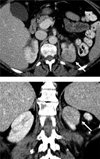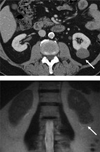Solid renal masses: what the numbers tell us
- PMID: 24848816
- PMCID: PMC4174582
- DOI: 10.2214/AJR.14.12502
Solid renal masses: what the numbers tell us
Abstract
Objective: Solid renal masses are most often incidentally detected at imaging as small (≤ 4 cm) localized lesions. These lesions comprise a wide spectrum of benign and malignant histologic subtypes, but are largely treated with surgical resection given the limited ability of imaging to differentiate among them with consistency and high accuracy. Numerous studies have thus examined the ability of CT and MRI techniques to separate benign lesions from malignancies and to predict renal cancer histologic grade and subtype. This article synthesizes the evidence regarding renal mass characterization at CT and MRI, provides diagnostic algorithms for evidence-based practice, and highlights areas of further research needed to drive imaging-based management of renal masses.
Conclusion: Despite extensive study of morphologic and quantitative criteria at conventional imaging, no CT or MRI techniques can reliably distinguish solid benign tumors, such as oncocytoma and lipid-poor angiomyolipoma, from malignant renal tumors. Larger studies are required to validate recently developed techniques, such as diffusion-weighted imaging. Evidence-based practice includes MRI to assess renal lesions in situations where CT is limited and to help guide management in patients who are considered borderline surgical candidates.
Figures










References
-
- Gill IS, Aron M, Gervais DA, Jewett MA. Clinical practice. Small renal mass. N Engl J Med. 2010;362:624–634. - PubMed
-
- Jayson M, Sanders H. Increased incidence of serendipitously discovered renal cell carcinoma. Urology. 1998;51:203–205. - PubMed
-
- Campbell SC, Novick AC, Belldegrun A, et al. Guideline for management of the clinical T1 renal mass. The Journal of urology. 2009;182:1271–1279. - PubMed
-
- Hollingsworth JM, Miller DC, Daignault S, Hollenbeck BK. Rising incidence of small renal masses: a need to reassess treatment effect. Journal of the National Cancer Institute. 2006;98:1331–1334. - PubMed
Publication types
MeSH terms
Grants and funding
LinkOut - more resources
Full Text Sources
Other Literature Sources
Medical

